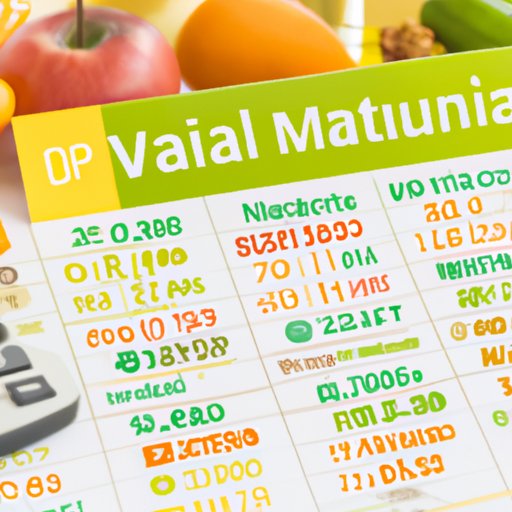Introduction
Nutritional value refers to the amount of energy, protein, vitamins, minerals, and other essential nutrients that are found in a given food. These nutrients provide essential energy and support for our bodies to function at their best. Understanding the nutritional value of common foods is an important part of maintaining health and wellness.

Exploring the Nutritional Value of Common Foods
When it comes to understanding the nutritional value of common foods, it’s important to know what nutrients are present in each food. Nutrients can be classified into two major categories: macronutrients (such as carbohydrates, proteins, and fats) and micronutrients (such as vitamins and minerals). Knowing which nutrients are present in different types of foods is key to making sure you’re getting all the essential nutrients your body needs.
Examples of nutrient content in different types of foods include:
- Fruits: Fruits contain vitamins, minerals, and fiber, as well as natural sugars.
- Vegetables: Vegetables contain a variety of vitamins and minerals, as well as antioxidants and fiber.
- Grains: Grains contain complex carbohydrates, protein, vitamins, and minerals.
- Dairy: Dairy products are rich in calcium, protein, and other essential vitamins and minerals.
- Meats: Meats contain high levels of protein and other essential vitamins and minerals.
A Comprehensive Guide to Understanding Nutrient Labels
To get a better understanding of the nutritional value of the foods we eat, it’s important to read the nutrition labels on packaged foods. Nutrition labels provide information about the amount of calories, fat, protein, carbohydrates, vitamins, and minerals that are present in a food product.
What information is included on a nutrient label? Generally, the label will include the following information:
- Calories: The number of calories per serving.
- Fat: The total amount of fat per serving, broken down into saturated and unsaturated fats.
- Carbohydrates: The total amount of carbohydrates per serving, broken down into dietary fiber, sugars, and other carbohydrates.
- Protein: The total amount of protein per serving.
- Vitamins and Minerals: The amount of various vitamins and minerals per serving.
It’s important to note that the label will also include a % Daily Value (% DV) section that shows the percentage of each nutrient that is present in the food relative to the recommended daily intake for that nutrient. For example, if the label indicates that a food contains 25% of the recommended daily intake for vitamin C, this means that one serving of that food provides 25% of the recommended daily intake for vitamin C.
The Benefits of Eating a Balanced Diet Rich in Nutrients
Eating a balanced diet rich in nutrients is key to maintaining optimal health. Macronutrients such as carbohydrates, proteins, and fats provide the body with energy, while micronutrients such as vitamins and minerals are essential for proper growth and development. It’s important to understand the difference between macronutrients and micronutrients, and to make sure you’re getting enough of both.
Certain vitamins and minerals are essential for optimal health. Vitamin A is important for healthy vision, Vitamin C supports the immune system, and Calcium is necessary for strong bones and teeth. Knowing which nutrients are essential for optimal health is key to making sure you’re getting enough of them in your diet.

What You Need to Know About Vitamins and Minerals
Vitamins and minerals are essential for good health and are found in a variety of foods. Different types of vitamins include fat-soluble vitamins (such as vitamins A, D, E, and K) and water-soluble vitamins (such as vitamins B and C). Minerals are divided into two categories: major minerals such as calcium, magnesium, and potassium, and trace minerals such as iron, zinc, and selenium.
It’s important to know the recommended daily intake (RDI) levels for each vitamin and mineral. The RDI for each vitamin and mineral is based on age, gender, and other factors, and can be found on the back of most nutrition labels. Making sure you’re meeting the recommended daily intake levels for each vitamin and mineral is key to maintaining optimal health.

How to Calculate Your Daily Nutritional Requirements
If you want to make sure you’re getting all the essential nutrients your body needs, it’s important to calculate your daily nutritional requirements. This can be done using an online calculator or app. When calculating your daily requirements, you should take into account your age, gender, activity level, and any special dietary needs.
When calculating your daily nutritional requirements, you should take into account your daily caloric needs, as well as your specific needs for macronutrients, vitamins, and minerals. Once you have calculated your daily needs, you can use this information to plan meals and snacks that will help you meet your nutritional goals.
Conclusion
Nutritional value is an important part of maintaining health and wellness. By understanding the nutritional value of common foods, reading nutrient labels, and calculating your daily nutritional requirements, you can make sure you’re getting all the essential nutrients your body needs. Eating a balanced diet rich in vitamins and minerals is key to achieving optimal health.
(Note: Is this article not meeting your expectations? Do you have knowledge or insights to share? Unlock new opportunities and expand your reach by joining our authors team. Click Registration to join us and share your expertise with our readers.)
